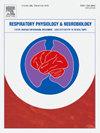Altered breathing pattern of lowlanders sleeping at high altitude: Novel insights from home sleep apnoea tests procedures
IF 1.6
4区 医学
Q3 PHYSIOLOGY
引用次数: 0
Abstract
Lowlanders sojourning at high altitude often experience sleep disturbances, which are driven by blood gases alterations and manifest as stress-related patterns, including frequent awakenings, apnoeas, reduction in sleep duration and possibly with the occurrence of periodic breathing. This study demonstrated clinical evidence of sleep disturbances at high altitude by using portable device during a Himalayan expedition. The home sleep apnoea test was conducted on 10 participants taking part in the "Lobuche Peak - Pyramid Exploration & Physiology". The longitudinal design included five assessments, before the expedition, at pre-expedition at Kathmandu (≈1400 m), at a peak altitude of ≈ 5000 m, upon return to Kathmandu and one month after return in Italy. Total sleep time was below 7 h of duration at the highest altitude in all participants. Nocturnal SpO2 dropped below daytime measurement and was greatly reduced at high altitude; conversely, heart rate increased. All participants experienced an increase in apnea-hypopnea index at high altitude, with seven out of 10 falling in moderate-to-severe grade. Periodic breathing pattern was clearly observed in two participants, of whom one developed acute mountain sickness and one did not. All the impairments were fully reversible once back at low altitude. Translationally, our findings underscore the importance of conducting home sleep apnoea tests at living altitude. Sleep-disordered breathing arises from a complex pattern that can be due to a wide range of responses, and the overall functions revealed by home sleep apnoea testing during a field expedition have the potential to increase the safety of high altitude sojourners, while advancing our knowledge of hypoxia as the red line linking respiratory and environmental physiology.
低地人在高海拔地区睡眠的呼吸模式改变:来自家庭睡眠呼吸暂停测试程序的新见解。
居住在高海拔地区的低地人经常会遇到睡眠障碍,这是由血气变化引起的,表现为与压力相关的模式,包括频繁醒来、呼吸暂停、睡眠时间缩短以及可能出现的周期性呼吸。本研究通过在喜马拉雅山探险期间使用便携式设备,展示了高海拔地区睡眠障碍的临床证据。对参加“罗布切峰-金字塔探索与生理学”的10名参与者进行了家庭睡眠呼吸暂停测试。纵向设计包括5次评估,分别在考察前、考察前在加德满都(约1400米)、高峰海拔约5000米、返回加德满都时和返回意大利一个月后。在海拔最高的地方,所有参与者的总睡眠时间都低于7小时。夜间SpO2低于白天测量值,在高海拔地区显著降低;相反,心率增加了。在高海拔地区,所有参与者的呼吸暂停低通气指数都有所上升,10人中有7人的呼吸暂停低通气指数呈中度至重度下降。两名参与者明显观察到周期性呼吸模式,其中一人出现急性高原反应,一人没有。一旦回到低空,所有的损伤都是完全可逆的。因此,我们的发现强调了在生活海拔进行家庭睡眠呼吸暂停测试的重要性。睡眠呼吸障碍是由一个复杂的模式引起的,可能是由于广泛的反应,在野外探险期间通过家庭睡眠呼吸暂停测试揭示的整体功能有可能提高高海拔旅行者的安全性,同时推进我们对缺氧的认识,将其作为连接呼吸和环境生理学的红线。
本文章由计算机程序翻译,如有差异,请以英文原文为准。
求助全文
约1分钟内获得全文
求助全文
来源期刊
CiteScore
4.80
自引率
8.70%
发文量
104
审稿时长
54 days
期刊介绍:
Respiratory Physiology & Neurobiology (RESPNB) publishes original articles and invited reviews concerning physiology and pathophysiology of respiration in its broadest sense.
Although a special focus is on topics in neurobiology, high quality papers in respiratory molecular and cellular biology are also welcome, as are high-quality papers in traditional areas, such as:
-Mechanics of breathing-
Gas exchange and acid-base balance-
Respiration at rest and exercise-
Respiration in unusual conditions, like high or low pressure or changes of temperature, low ambient oxygen-
Embryonic and adult respiration-
Comparative respiratory physiology.
Papers on clinical aspects, original methods, as well as theoretical papers are also considered as long as they foster the understanding of respiratory physiology and pathophysiology.

 求助内容:
求助内容: 应助结果提醒方式:
应助结果提醒方式:


